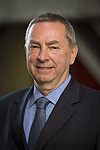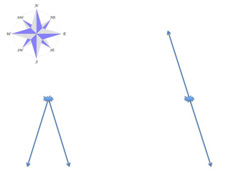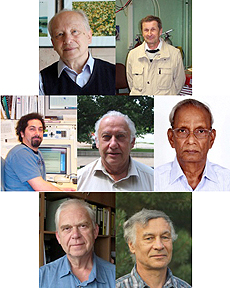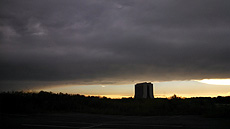|
Thursday, Aug. 28
- Breakfast: Canadian bacon, egg and cheese Texas toast
- Breakfast: Mexican omelet
- Steak soft tacos
- Smart cuisine: braised beef with vegetables
- Chicken vindaloo
- Baked ham and Swiss ciabatta
- Pork carnitas soft tacos
- Beef barley soup
- Chef's choice soup
- Assorted pizza by the slice
Wilson Hall Cafe menu |
|
Friday, Aug. 29
Dinner
Closed
Wednesday, Sept. 3
Lunch
- Spinach- and feta- stuffed portobello mushrooms
- Poppy seed fruited slaw
- Blackberry crumb cake
Chez Leon menu
Call x3524 to make your reservation.
|
|
Restructuring the FRA Board
 |
Fermilab Director
Nigel Lockyer
|
Fermi Research Alliance LLC, the operator of Fermilab for the U.S. Department of Energy and a partnership between the University of Chicago and Universities Research Association, is reorganizing its board of directors this fall to best support the laboratory as it shapes its future as a world-leading scientific institution, working in close partnership with the scientific community to ensure a bright future for U.S. particle physics.
The FRA Board provides strategic guidance, oversight, direction and advice to Fermilab management. The reorganized 15-member board will strongly emphasize support and advice in matters of project management, governance, industrial expertise, government relations and international collaboration.
This expertise on our board will be crucial as we continue the work already begun to restructure and realign our lab to match the demands of the P5 plan. The plan calls on Fermilab to transform into a laboratory capable of hosting a world-leading international accelerator-based neutrino program while playing key roles in Large Hadron Collider research, muon physics, and the quest to understand dark matter and energy.
The P5 plan highlights one major challenge our laboratory will face over the next decade: carrying out the largest suite of construction projects within the DOE Office of Science. Another is developing an Illinois Accelerator Research Center program that turns Fermilab into a hub for industrial development of the next generation of particle accelerators, products and applications.
The goal of a reorganized board will be to support the lab management team as we seek to meet these challenges and to improve our overall operations performance. The board will also continue to assess our scientific strategy, in close consultation with the Physics Advisory Committee and as guided by national advisory groups.
The reorganization was determined by the two members of FRA, the University of Chicago and Universities Research Association Inc. It will be overseen by an interim board that will be convened on Oct. 1. The interim board will include Robert J. Zimmer, chairman of the board and president of the University of Chicago; vice chairman of the board and Michigan State University President Lou Anna K. Simon; Marta Cehelsky, executive director of Universities Research Association; and Donald Levy, vice president for research and national laboratories at the University of Chicago. The full board reorganization will be completed in 2015.
|
September wellness offerings, fitness classes and discounts
Complimentary Wellness
Lunch and Learn: Tai Chi and Qigong: Health vs. Fitness
Tuesday, Sept. 9, noon-1 p.m.
WH8XO Hornet's Nest
Tai Chi and Qigong
Mondays and Fridays, Sept. 15-Dec. 19, noon-1 p.m.
Ramsey Auditorium
Wednesdays, Sept. 17-Dec. 17, 7-8 a.m.
Ramsey Auditorium
Sign-up requested. Email shandvi@fnal.gov.
Lunch and Learn: Living Well Cancer Resource Center
Tuesday, Sept. 30, noon-1 p.m.
Curia II
Weight Management Class
Lifestyle Patterns Approach to Weight Management
Thursdays, Sept. 18-Nov. 20, noon-1 p.m.
Curia II
$50/person/10 weeks. Register by Sept. 11.
Fitness Classes
Butts and Guts
Wednesdays, Sept. 3-Oct. 8, 11:45 a.m.-12:30 p.m.
Fitness Center Exercise Room
$60/person/6 weeks. Register by Aug. 27.
Strength Training
Tuesdays and Thursdays, Sept. 4–Oct. 28, 5-6 p.m.
Fitness Center Exercise Room
$82/16 classes. Register by Aug. 28
For more class information or to register for a class, visit the wellness Web page.
Athletic League
Outdoor soccer
Tuesdays and Thursdays, 6 p.m.
Fermilab Village soccer field
Contact O'Sheg Oshinowo for more information.
Employee discount
Hollywood Palms Employee Appreciation Day
Batavia Smashburger
Visit the Employee discounts Web page
|
Physicists want to know if we're all actually living in a hologram
From Gizmodo, Aug. 26, 2014
Although it sounds entirely like something dreamed up in a smoke-filled dorm room, whether the entire universe is hologram is a very serious question — a question that gets at the heart of a fundamental problem in physics. A new experiment starting up at Fermilab just might hold the answer.
Fermilab, a government-funded research campus on the prairie outside Chicago, might be best known for having the highest energy particle accelerator in the world — until the LHC superseded it in 2009. Since then, Fermilab has made itself busy with physics projects smaller in physical size but no less ambitious. Craig Hogan's Holometer experiment is one of them. For years now, Hogan has been building a pair of L-shaped instruments underground to measure "noise" that could prove the holographic principle.
Read more
|
|
Which way did it go?
 |
| Which way did it go? On the left, it went south. On the right, it went nowhere.
|
Disponible en español
In the DZero detector, the direction in which a particle travels — the direction of its momentum — is often easier to measure precisely than its energy or, equivalently, its amount of momentum. This is the key idea behind a recent result.
Put a flat piece of paper on your desktop. This is what particle physicists call the transverse plane. Now take a pencil and try to balance it on its point on the paper. You don't have to succeed — just get the idea of something going perpendicularly into the paper. This depicts the proton going into the collision. The antiproton is traveling in the opposite direction, also perpendicular to the paper (excuse me: also perpendicular to the transverse plane). If the two are aligned and strike each other, then there is a collision point in the transverse plane. Pick the pencil up; there might be a little mark left from the pencil tip to show you where the collision happened.
Now let us draw some arrows coming out from that little mark. These are the directions of the particles coming out of the collision. By drawing them on the paper, you draw only two dimensions of the motion — a particle might come out with a motion that is partly upwards and to the left, but on the paper you can only draw it to the left. This is what particle physicists call projecting onto the transverse plane.
In the above figure you see a pair of possibilities for the projection onto the transverse plane of two particles from a collision. These two particles are the decay products of a very heavy particle created in the collision. The two particles on the left came from some heavy particle that was clearly headed south according to the compass. The two particles on the right came from a heavy particle that was clearly going nowhere.
The method of the recent DZero result is a bit more complicated than this, but you have enough to get the basic idea. When a proton and an antiproton collide and produce a Z boson, the Z boson might decay into a pair of muons. The direction of the muons tells us how the Z was moving in the transverse plane. What scientists actually do is take the angle that you see in the figure, which is called the acoplanarity, and apply a certain correction to it to obtain an angle that theorists can predict and experimentalists can measure. More to the point, this angle, called Φ* and invented in part by DZero collaborators, is experimentally a more precise measure of the motion of the Z (as projected onto the transverse plane) than that obtained by measuring just the momentum of the muons in the transverse plane directly.
The theoretical prediction relies on being able to calculate the effects of the strong nuclear force accurately, and this is a notoriously difficult thing to do. So in this case, comparing the data to the prediction is more a test of our ability to apply the theory than a test of the theory itself.
DZero finds that the data and the theoretical predictions are in good but not perfect agreement. At Φ* near 30 degrees, the DZero measurement is higher than the prediction, but the prediction is not very definite. Now it is the theorists' turn to try to improve our ability to apply the theory.
—Leo Bellantoni
 |
| Xingguo Li, Mika Vesterinen, Terry Wyatt and Yang Qin, all of the University of Manchester, England, are the primary analysts for this result.
|
 |
| Groups from various countries, in addition to the United States, provided major contributions to the design, construction and operation of the DZero muon system on which this analysis strongly relies. The leaders of these groups are: Top row, from left: Sergei Denisov (IHEP, Protvino, Russia), George Alkhazov (NPI, St. Petersburg, Russia). Middle row, from left: Karel Soustruznik (Charles University, Prague, Czech Republic), Vladislav Simak (Czech Technical University, Prague), V.S. Narasimham (TIFR, Mumbai, India). Bottom row, from left: Milos Lokajicek (Academy of Sciences of the Czech Republic, Prague, Czech Republic), Vladimir Gavrilov (ITEP, Moscow, Russia). Not pictured: Guennadi Alexeev (JINR, Dubna, Russia)
|
|
Gathering clouds
 |
| Clouds lay over Fermilab grounds like a giant swath of cotton on Monday. Photo: Lauren Biron, DI |
|
|